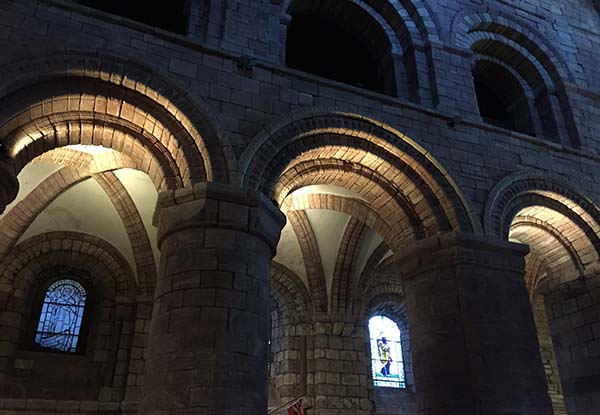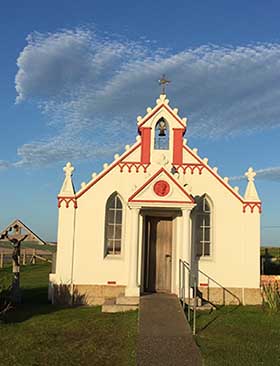
For a very small town (population round 9,000) whose surrounding fields you can see from its centre, Kirkwall has a fine collection of antique buildings. This is what’s left of the 16th century bishop’s palace (replacing 12th century, 13th century and 14th century palaces) which stands, reasonably enough, just across the road from St Magnus cathedral.
St Magnus is a very substantial red sandstone pile started in 1137 by Norwegian Earl Rognvald Kolsson who just had managed to snatch Orkney from its existing earl. Craftily he had combined a charm offensive on the locals (promising to build them a magnificent cathedral in honour of their favourite saint, St Magnus) with kidnapping and disposing of the existing earl. Bingo! Even though he was in turn murdered 20 years later by a rebellious Scottish chieftain, he did build the cathedral and, for his pains, was actually canonised in 1192 – although ‘some doubts exists as to the validity of his sainthood’.

Whatever about his sainthood his cathedral is very impressive, especially inside. A hugely tall, narrow nave flanked by massive round Norman columns….

..and all of the columns topped by equally massive layers of Norman arches.

If you want to know more about St Magnus and the gory events which surged around the cathedral, check in to Orkneyjar here.
 The Orkney islands are home to some corking archeological ruins and lots of standing stones. I am horribly ignorant about standing stones, and not much less so about archeological remains.
The Orkney islands are home to some corking archeological ruins and lots of standing stones. I am horribly ignorant about standing stones, and not much less so about archeological remains.
However, even I had heard of Scara Brae, the neolithic village that was revealed almost totally intact in 1868 when a particularly vicious stormed stripped the grass from a section of sand dunes on the west of the Orkney mainland.

The site is amazingly preserved although under constant threat from the sea. I arrived too late for the visitor centre but the site itself was deserted so I manage too snuk in for a quick look. For more about it, check in once again to Orkneyjar.
 And while you are on the road you also need to leap forward 20 odd centuries to visit the Italian chapel built by Italian prisoners of war in 1943/4.
And while you are on the road you also need to leap forward 20 odd centuries to visit the Italian chapel built by Italian prisoners of war in 1943/4.
The prisoners had been captured during the North African campaign in 1942 and were put to work building ‘Churchill barriers’, the concrete causeways that protected Scapa Flow, the massive natural harbour which was home to the British fleet.
The Italians had already landscaped the grounds around their huts and built a theatre and late in 1943 they were given two Nissen huts to create a chapel. The huts were place end to end and the POWs were given free reign to decorate it. They included a painter, Domenico Chiocchetti, a cement worker, an electrician and a blacksmith and together they fashioned a truly Italian chapel. (For a lovely obituary of Chiocchetti in the Independent in 1999 see here.) The Orcadians were so touched by the Italians’ faith and achievement in building the chapel that they have preserved it ever since.

Well, so much for culture – what about the bere barley…….

Bere barley is to barley what einkorn, spelt or kamut is to wheat – an ancient variety of barley, largely forgotten for centuries and now, just in the nick of time, being rediscovered. Bere, which is a six row barley (‘normal’ barley only has two rows) has certainly been grown in Orkney for thousands of years and was well adapted to the short growing season and the acid soils. However, it lost ground, as did so many of the older forms, to the high yielding modern barleys developed in the 19th century.

That it survived at all in Orkney is thanks mainly to the Barony Mills in Birsay, now a charitable trust supported by the Agronomy Institute at Orkney College. This is the watermill (an ‘over the top’ wheel) at Barony Mills which has been functioning since 1873. When the mill is running it need 110,000 gallons of water per hour flowing from the Boardhouse Loch to keep the wheel turning and the innumerable wheels and grinding stones inside the mill operating.
Bere barley is difficult to grind. It needs to be dried, ‘shelled’ (cracking the outer husk), fanned, cleaned and then passed through two different mill stones to achieve fine, medium or coarse flour. We were given a fascinating tour of the mill in operation but I am afraid that I lost track quite soon. However, I did whisk out the trusty iPhone so here, along with all the accompanying grunts and mutters from the hoary old wood and cast iron machinery are, very briefly, three of the processes.
The resulting flour/meal is delicious – like a very wholemeal barley but with a rich, almost beery flavour. (Although it would not, of course, be suitable for coeliacs as it is still barley, it is low gluten so for those who are merely trying reduce their intake of gluten, not avoid it completely, it would be worth some careful experimentation.) You can buy the flour from a number of shops on line (just Google bere barley) – and you can also buy it made up into oatcakes and shortbread – or use it in your own baking.
(Since coming back to London I have been ordering the most delicious bere barley oatcakes from Stockans on Orkney – they have just sent me a big box including some of their VERY tasty black pepper and cheesey oatcakes. They are extremely helpful and I would thoroughly recommend them.)
The Science Festival booklet I was given about bere barley suggested this recipe for Bere Bannocks which I suspect came from our good friend Liz Ashworth since she had written the booklet!!
2 tbsp beremeal sifted with 1 tbsp wheat flour and 1 heaped tsp baking powder
pinch sea salt
Mix to a soft dough with water or milk. Drop onto a medium-hot girdle, sprinkle with beremeal and pat out with the palm of your hand to make round scone shape about 5cm (2 ins) thick. Bake on a medium heat till firm on the base, lift and turn to bake again till firm. Don’t be in a hurry because bere burns easily.
Knock with your knuckles on the surface of the bannock – if it sounds hollow the bread is baked. Cool on a wire tray and enjoy warm and freshly baked.
 For variations try adding:
For variations try adding:
- Smoked sausage, chopped spring onions and tomato
- Smoked Orkney cheddar and ham
- Sweetcorn, sunflower seeds and baked beans
This image comes from the Shipton Mill site where it illustrates a long and interesting article about bannocks!
